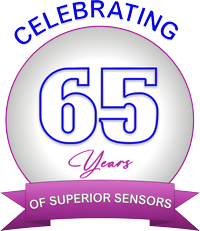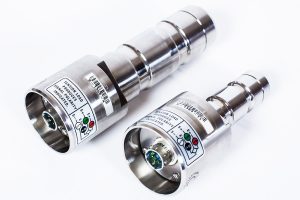Force Sensing Load Pins
Specifications
Typically load P is applied at the center of the pin and the pin is supported at each end (P/2) by the Clevis. The strain gages are sealed inside small axial holes and are positioned at two locations at the clevis to clevis eye interfaces. In order to sense only those strains which are induced by the shear forces at these two sections, the gages are positioned and oriented with great precision, at a neutral plane relative to one specific direction of pin loading. The four strain gages (two at each location) are electrically connected to form a full bridge, the signal from each gage being additive so that the bridge output is proportional to the sum of the loads transmitted by the shear planes of the pin. The circuit typically includes temperature compensating, signal trim (optional) and balance resistors terminating in suitable connector socket or integral cable. Strainsert factory calibrations are intended to simulate installed conditions, however, it is recommended that an in-place calibration be performed to account for any installation, tolerance, and/or alignment influences affecting sensor measurement.
If the force F is applied to the pin at other than the specified direction, the theoretical bridge output will be due to the component of the force along the sensitive direction, i.e. F cos X (Spec. Drawing Above). Therefore, typical pins incorporate an anti-rotation device for proper alignment, see Clevis Pin Installation for details.
The clevis pins or clevis bolts can be designed for extreme durability under even the most severe conditions temperature variations or working environments. These products have a wide range of applications, have a long operational life and are currently used on a variety of applications from simple force measurement solutions up to such cutting edge projects as the Mars Exploration Rover Mission for NASA, the Space Shuttle launching pad and hydrostatic or submersible vehicles deep under the ocean’s surface.
Applications
Some Applications Include:
- Structural Tests
- Flight Simulators
- Winch/Crane/Lifting Systems
- Landing Gear Clevis Joints
- Mooring Lines/Lanyards
- Sprocket/Pulley Axles
- Bombay/Cargo Doors
- Railroad/Towbar Connections
- Armanent Suspension Systems
- Rocket Reaction Forces
- Aircraft Wing Joints
- Conveyors
- Test Machines
- Hydraulic Actuators
- Nuclear Fuel Rod Control
- Robotic Pin Joints
- Sheave Axles
- Ground Support Equipment
Strainsert – for superior internally gaged force transducers.
Strainsert stands for:
- Product Quality
- Knowledgeable Technical Staff
- Standard and Custom Designs
- Customer Service
- Comprehensive Testing
Contact Strainsert
For information on load pins, force sensing bolts, load cells, tension links or our high quality custom products, Contact Us for further assistance.


